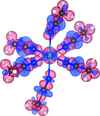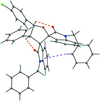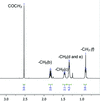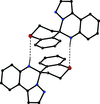issue contents
November 2015 issue

Cover illustration: A short S I halogen bond occurs in the cocrystal formed by dithiocyanatotetrakis(4-vinylpyridine)nickel(II) and 2,3,5,6-tetrafluoro-1,4-diiodobenzene. Such halogen bonds to sulfur are significantly less common than to smaller electronegative atoms. See Serb, Merkens, Kalf & Englert [Acta Cryst. (2015), C71, 991-995].
I halogen bond occurs in the cocrystal formed by dithiocyanatotetrakis(4-vinylpyridine)nickel(II) and 2,3,5,6-tetrafluoro-1,4-diiodobenzene. Such halogen bonds to sulfur are significantly less common than to smaller electronegative atoms. See Serb, Merkens, Kalf & Englert [Acta Cryst. (2015), C71, 991-995].
research papers
Download citation


Download citation


The crystal structure of a homoleptic CrII complex and a study of its electron density are described. The [Cr(CH3CN)6]2+ species is a high-spin d4 complex with a strong static, rather than dynamic, Jahn–Teller distortion. Topological features of the electron-density distribution are explored and linked to the observed Jahn–Teller distortion.
CCDC reference: 1420167
Download citation


Download citation


The structures of a new polymorph of sulfameter, polymorph III, and of the dioxane and tetrahydrofuran solvates have been determined. The three structures are stabilized by strong N—H⋯N intermolecular interactions which have been analysed using Hirshfeld surfaces.
Download citation


Download citation


In the crystal structures of raffinose N-hydrates (N is a hydration number between 4 and 5), the hydrogen-bonded chain composed of two water molecules and one of the –OH groups of the galactose ring (chain A) is disordered over a similar chain composed of one water molecule and the –OH group (chain A′), with an occupancy ratio of (N − 4):(5 − N). Chain A is transformed to chain A′ during the dehydration of the pentahydrate.
Download citation


Download citation


The solvent-free form and the N,N-dimethylformamide disolvate of a bis(thiosemicarbazide) exhibit different internal symmetries and different molecular conformations, and they form different types of hydrogen-bonded sheets.
Download citation


Download citation


Two RuII carbonyl complexes derived from 4,5-diazafluoren-9-one exhibit different modes of binding of this ligand and are of interest with regard to CO release in biological systems.
Download citation


Download citation


A new coordination polymer, [Cu2(hmph)(N3)2(py)2]n (hmph is homophthalate and py is pyridine), was synthesized and characterized as having a one-dimensional chain structure composed of tetranuclear CuII units containing (μ1,1-N3−)(μ-syn–syn-COO−)2 and (μ1,1-N3−)2 bridges, and exhibits dominant antiferromagnetic behaviour.
CCDC reference: 1041812
Download citation


Download citation


In two isatin (1H-indole-2,3-dione) compounds, the ring systems are planar and the bicyclic scaffolds are almost superimposable. Both crystal structures are stabilized by C—H⋯O interactions.
Download citation


Download citation


In order to explore new metal coordination polymers and to search for new types of ferroelectrics among hybrid coordination polymers, the use of the 4-(dimethylamino)pyridin-1-ium-1-acetate anion and the 1-cyanomethyl-1,4-diazoniabicyclo[2.2.2]octane dication as templates for the formation of two different cadmium(II) coordination polymers was investigated.
Download citation


Download citation


In two novel cocrystals of the N(7)—H tautomeric form of N6-benzoyladenine (BA), i.e. with 3-hydroxypyridinium-2-carboxylate (3HPA) and DL-tartaric acid (TA), the BA Watson–Crick face interacts with the 3-HPA molecule in the former, while the BA Hoogsteen face interacts with the TA molecule in the latter. Typical inter- and intramolecular hydrogen-bonding and stacking interactions are observed in both crystal structures.
Download citation


Download citation


A short S⋯I halogen bond occurs in the cocrystal formed by dithiocyanatotetrakis(4-vinylpyridine)nickel(II) and 2,3,5,6-tetrafluoro-1,4-diiodobenzene. Such halogen bonds to sulfur are significantly less common than to smaller electronegative atoms.
CCDC reference: 1430361
Download citation


Download citation


The crystal structure of the intermetallic compound Gd3Ni7Al14 belongs to a family of two-layer structures and can be described as an assembly of interpenetrating centred straight prisms. The close relationship with PrNi2Al and ZrNiAl is discussed.
CCDC reference: 1427954
Download citation


Download citation


Weak interactions play a prominent role in the structural stability of dispirooxoindoles and contribute to their highly regio- and diastereoselective synthesis.
Download citation


Download citation


The 1:1 pharmaceutical cocrystal of the antituberculosis drug pyrazinamide (PZA) and p-aminobenzoic acid (p-ABA) has been prepared and thoroughly characterized using relevant solid-state characterization methods. Interestingly, the components of the cocrystal reacted in the molten state to give the corresponding carboxamide with the release of ammonia. Both crystal structures are governed by coventional O—H⋯O, N—H⋯O and N—H⋯N hydrogen-bonding interactions.
Download citation


Download citation


In a new zinc(II) coordination polymer based on multidentate N-donor 2-[(1H-imidazol-1-yl)methyl]-1H-benzimidazole (imb) and bridging O-donor benzene-1,2-dicarboxylate (bdic2−) ligands, binuclear [(Zn)2(imb)2] units are connected alternately by pairs of bridging bdic2− ligands, yielding an infinite one-dimensional chain.
CCDC reference: 1431803
Download citation


Download citation


Single-crystal crystallographic analysis allowed the identification of an unexpected rearranged by-product of an Ullmann reaction as 1-(4-hexyloxy-3-hydroxyphenyl)ethanone and a possible mechanism for its formation is suggested.
CCDC reference: 1432541
Download citation


Download citation


In a spiro[pyrazolo[1,5-c]quinazoline-5,4′-thiochroman], prepared under very mild reaction conditions, the two nonplanar heterocyclic rings show different conformations. Hydrogen bonds of the N—H⋯S and C—H⋯π(arene) types link the molecules into complex sheets.
CCDC reference: 1433058


 journal menu
journal menu

































